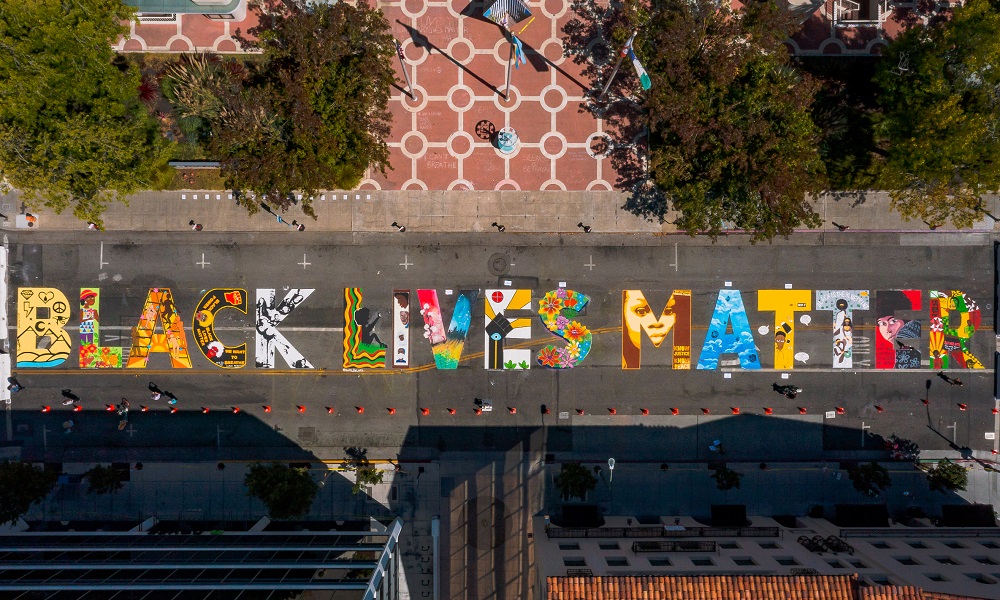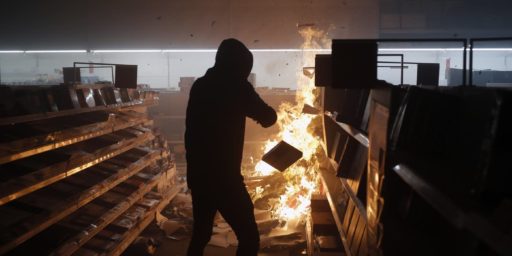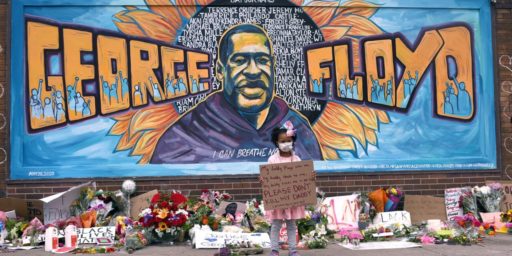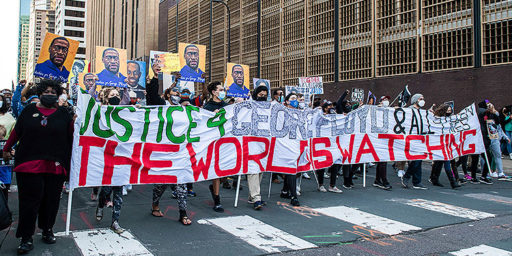Two Years After George Floyd
Very little progress has been made towards racial justice.

In an essay entitled “The Great Erasure,” NYT columnist Charles M. Blow reminds us that Wednesday will mark the second anniversary of the murder of George Floyd by a Minneapolis police officer. (I must admit, it seems like it’s been longer than that.) His core lament is sobering:
Some good came of the protests, to be sure. Some states and local municipalities passed or instituted police reforms. Money poured into Black Lives Matter, as well as other racial justice organizations and Black institutions. Individuals began personal journeys to become more egalitarian and more actively “antiracist.” And artists produced hundreds of murals and thousands of pieces of other street art that, for a time, transformed this country.
In the end, transformative national change proved to be an illusion. Inflation, a war in Ukraine, public safety, abortion and even a baby formula crisis have overtaken the zeitgeist. Support for Black Lives Matter has diminished. Federal police reform and federal voter protection both failed to pass the Senate. And the founders of Black Lives Matter have been drawn into controversies about how they handled its money.
I’ve learned not to expect much from America; it has a deep capacity for change but a shallow desire for it. I have embraced the “wise desire not to be betrayed by too much hoping,” as James Baldwin put it. But I worry about young people in all of this. It is their faith that’s most vulnerable to damage. They were the ones who most believed that change was not only possible but imminent, only to have America retreat and retrench.
Now not only are their allies reversing course on issues like police reform; the country is also facing a full backlash toward protest itself. Dozens of states have passed laws restricting the right to protest (just this week, Gov. Ron DeSantis of Florida barred citizens from protesting outside private homes), and more than a dozen have now criminalized teaching full and accurate racial history.
But the vast bulk of the feature—one of those odd, hard-to-navigate interactive web projects that NYT has proliferated in recent months—and the one that gives its title strikes me as odd.
The Great Erasure is underway, not so much an attempt to erase the uprising itself as an attempt to blunt its effects.
THERE IS NO EXAMPLE of this erasure more striking than the continual destruction, removal or slow vanishing of much of the street art produced in the wake of Floyd’s killing.
According to a database compiled by three professors at the University of St. Thomas in Minnesota — Heather Shirey, David Todd Lawrence and Paul Lorah — there were once approximately 2,700 murals, graffiti, stickers, posters affixed to surfaces and light projections created in response to Floyd’s killing, mostly in the Twin Cities of Minneapolis and St. Paul. Shirey and Lawrence called it “the largest proliferation of street art around one idea or issue or event in history.” But many of those pieces have disappeared, sometimes because of exposure to traffic or the elements and sometimes because of deliberate attempts to erase them. Business owners quietly removed the graffitied planks from their storefronts. Some of the murals have been defaced.
There’s a whole lot more of this, including photos illustrating the beauty of many of these lost pieces of artwork. I can understand being wistful that most of them are being lost. But of course they are. The vast majority were “street art” in the most literal sense. As in, literally painted on streets. There’s not a paint made that can withstand being walked and driven on for long. And even the most ardently pro-BLM business owner was going to eventually unboard his shop in order to resume making a living.
That “Some of the murals have been defaced” is more noteworthy. On the one hand, protest is going to garner counter-protest. Given that essentially none of the people putting up BLM graffiti had the legal right to do so, desecrating it is just as legitimate a form of protest as putting it up to begin with. On the other, the motives are clearly not equal. While I disagree with some of the demands made by some BLM supporters, the basic sentiment—anguish and outrage over the fact that the state is still wantonly killing young Black men this many generations after the end of slavery and even the end of Jim Crow—behind the movement is unassailable. It’s hard to imagine being motivated to paint over a message as benign as “Black Lives Matter” with good intent.
Here, Blow gets back on track:
Further complicating the preservation efforts is the degree to which these pieces of art were politicalized from the moment of their creation: Murals were going up as Confederate monuments in cities like Montgomery, Ala., continued to come down. It fueled the fears held by white supremacists that white people and white culture would eventually be superseded.
In their zero-sum worldview, BLM’s pro-Blackness was inherently anti-white. President Donald Trump called a Black Lives Matter mural to be painted in front of Trump Tower in New York City a “symbol of hate.” Historical revisionists held fast to the lie that Confederate monuments were about history, rather than racism. The fight was over which art representing which points of view was more deserving of public display.
It’s perhaps also no coincidence that much of the artwork created after Floyd’s death is vanishing as the public embrace of the Black Lives Matter movement is waning. Polls last year by the Pew Research Center found that support for Black Lives Matter, which peaked in the immediate aftermath of George Floyd’s death, had fallen back to its 2017 levels, pre-George Floyd. Black support had remained high; it was the support among white people that fell.
BLM was politicized because it was inherently political. While its bottom-up nature meant that there was never a coherent policy message—and extreme offshoots like “Defund the Police” were easily spotlighted by opponents as core to the movement—it was always a demand for change.
Indeed, the rapid fall of Confederate monuments, which had been bitterly contested for decades, would simply not have happened absent BLM. It wasn’t happenstance that they were coming down as the street art went up—it was a change in the zeitgeist. But seemingly an ephemeral one.
It’s hard to know what to make of the linked Pew survey. They’ve polled the topic four times: August 2017. June 2020, September 2020, and September 2021. The overall support for BLM was exactly 55 percent in the first two of the surveys, 67 percent in the third, and 55 percent again in the most recent. The most obvious conclusion is that we’ve simply got a bad poll in there. It’s possible that September 2020 marked a genuine peak of sympathy for a movement before it faded back to baseline. I’m skeptical, though. By that point, violence had become well-associated with the movement, with rioting all across the country by May. Ditto the aforementioned “Defund the Police” offshoot. Those were naturally going to spur white backlash.
Regardless, I’m less concerned about the loss of artwork that was designed to be ephemeral or even the shifting of political support for an amorphous movement than I am about actual progress toward social justice. And, while removal of moments to the Confederacy seems to be continuing apace, I fear we’re otherwise mostly moving in the wrong direction.
Blow again:
[P]olice killings have continued unabated. In fact, last year saw a record number of police shootings, the most since The Washington Post began keeping count in 2015. The police killed 1,055 people across the country in 2021. And yet, there were no nationwide protests.
In my life I have arrived at the conclusion that real liberation — equity, safety and “the pursuit of happiness” — is not rooted in feelings and personal evolutions. Only a change in the parameters of power — political, economic and cultural, who has it and who gets to exercise it, who is benefited by it and who is harmed by it — can transform this country.
Alas, working-class whites seem to have come to the same conclusion. After a quarter-century of forecasts that the combination of urbanization and demographic change would yield a permanent political change, a sinister mirror image, Replacement Theory, seems to have gone mainstream. And, as we’ve seen, everything from suppression of the non-white vote to outright election theft has been embraced as means of forestalling that inevitability and keeping political and cultural power.
We see this divide in the Pew survey:
More than eight-in-ten Democrats and Democratic-leaning independents (85%) express at least some support, including 48% who strongly support the movement. In contrast, most Republicans and those who lean to the GOP (78%) say they oppose the Black Lives Matter movement, with 58% saying they strongly oppose it.
Similar shares of Black (90%) and White (87%) Democrats say they support the Black Lives Matter movement at least somewhat, while smaller but still large majorities of Hispanic (77%) and Asian (80%) Democrats say the same. Black Democrats are far more likely than their White, Hispanic or Asian counterparts to express strong support for the movement.
Among Republicans, there is more support for the movement among those who are Hispanic (29% express at least some support) than among those who are White (16%), but majorities of White (82%) and Hispanic (68%) Republicans say they oppose it. There are not enough Black or Asian Republicans in the sample to analyze these groups separately.
Younger adults and those with higher levels of educational attainment are more likely than those who are older and those with less education to say they support the Black Lives Matter movement. These patterns are consistent with past findings on this question.
Two-thirds of adults younger than 30 express at least some support, as does a narrower majority of those ages 30 to 49 (58%). About half of adults ages 50 to 64 (49%) and 46% of those 65 and older say they support the movement.
Among those with a postgraduate degree, 64% say they support the Black Lives Matter movement, as do 58% of those with a bachelor’s degree. Some 53% of those with some college and 50% of those with a high school diploma or less education say the same.
We’ve essentially fully sorted at this point: Whites are mostly Republican and Blacks are overwhelmingly Democrats. And the whites who are Democrats are mostly young or very well educated.
Indeed, Ruy Teixeira, the most prominent of those who forecast the Emerging Democratic Majority, admits that he failed to see how aggressive this sorting would be:
We very specifically said — and this is widely ignored — that for this majority to attain and exercise political power, you have to retain a significant fraction of the white working class. The country was changing, but it wasn’t changing that fast.
The second thing we didn’t anticipate was the eventual effect of professional-class hegemony in the Democratic Party — that it would tilt the Democrats so far to the left on sociocultural issues that it would actually make the Democratic Party significantly unattractive to working-class voters.
It’s a huge liability for the Democrats, because the people who staff the party, the people who staff the think tanks, the advocacy groups, the foundations, the staffers, they’re all singing from the same hymnal to some extent. They live in this liberal cultural bubble, particularly the younger members.
Of course, this is true of the Black working class as well. Not only are they not eager to see the police defunded they roll their eyes at the obsession with things like student debt, which is simply not a factor in their community. But the increasingly-open appeals of Republican Party leaders to white nationalism give them no other choice.
Interestingly, according to a Gallup poll released late last week, Americans across the board agree that race relations are poor.
The trends show that worry about race relations increased sharply across racial/ethnic groups between 2001-2014 and 2015-2019. Concern then eased among White adults in 2020 while staying fairly flat among Black and Hispanic adults.
Since then, concern about race relations has increased among all racial/ethnic groups — although more among Black adults, rising 20 percentage points to 74%, than among White adults (up 15 points to 39%) and Hispanic adults (up nine points to 49%).
But, of course, “worry a great deal” means different things to different people. And I suspect a goodly number of white folks worry that things are shifting against their interests rather than about a lack of social justice.





Black Lives Matter, but (feel free to insert Jim Wright’s emergency “not all” here) white people answered with Blue Lives Matter (more). The “more” my have been unspoken but it was impossible to miss. Cops were saying it loud and clear and heard the response in support as permission to continue as tho nothing had changed.
And of course, nothing has.
Newton was wrong. The reaction is opposite but far stronger.
I think people on the left thought maybe this was some kind of “One and Done” thing. It isn’t. It will never be. We need to continually push, in whatever way seems to work the best, for justice and equality. The need to do this will last a lifetime, since human psyches find it difficult to implement. It does not run on its own.
This is the thing I really want younger people to get. This is a marathon, not a sprint. We need to change deep-seated attitudes, not the color of the drapes. That can be done, but it is a long, slow process.
Honestly, the pushback from the right doesn’t bother me that much. Phrases like “white people are mostly Republican” do bother me a bit, being as I am, demographically speaking, a poster child for Republicanism, and yet I am not, nor have I ever been.
But pushback? Of course there will be pushback. Even the way I do things, with what is basically one-on-one advocacy, there’s pushback.
I mean, on Steven’s recent post about Ginni Thomas I observed that advocacy is far more about dedication and persistence than it is about analysis or observation.
The very thing that has the Right so alarmed is that they see the Left winning every battle. That’s only a slight exaggeration.
So I demur on Blow’s thesis. Of course they want to erase it, that’s to be expected. That’s no way to measure progress, though, nor any reason to despair.
I’ve long suspected the biggest mistake the Dems continue to make is, when addressing the issue of poverty, nearly always citing urban black poverty. There are a lot of poor rural whites whose natural self-interest is New Deal/Great Society-ish. Those programs came into being with the support of southern whites, and the lot of black people was hardly ever mentioned.
This has been exploited by the FOXies, et al, to the degree that the rural whites have come to believe ALL government programs are welfare for blacks. LBJ described how effectively this I-op works:
“If you can convince the lowest white man he’s better than the best colored man, he won’t notice you’re picking his pocket. Hell, give him somebody to look down on, and he’ll empty his pockets for you.”
The issue of police shootings isn’t strictly a problem for black people either. It stems IMO from poor training doctrine, the increasing popularity of “warrior police” attitude instilled by Grossman and his ilk. Municipalities have discovered how expensive police who have become convinced they are about to be shot at any moment can be. The push-back has begun. It will take some time.
@dazedandconfused:
So, you’re suggesting the Black people move to the back of the bus?
Ok, random aspersions aside, I get what you mean. If the Democrats were able to get poor, rural whites thinking of poverty rather than race, we would do a lot better. But, as you also note, this really only happened when Blacks weren’t mentioned.
And, yes, police violence is the same way.
I have no idea how that happens, but given that the electoral college and the Senate give the empty, white, poor states a huge advantage, it pretty much has to happen or they will take us down with them.
The constitution turns out to be a suicide pact.
Maybe Biden can announce the arrest of a child sex trafficking ring.
@Gustopher:
Reality is nasty stuff, I expected insults. No worries.
@Gustopher:
I thought they were not going after trump.
@Kathy: It might be the Southern Baptist Church…..holy shit, some of the excerpts I’ve read so far are pretty damning as far as criminal conspiracy.
@Gustopher:
It’s worse. It only happened when there were carve-outs that, coincidently, excluded a lot of the non-white poor. There were and are a lot of poor whites that would rather do without than see the wrong people get government assistance. Hopefully there are enough that just want theirs and don’t mind others getting help too to build a strong enough coalition with and hopefully the dems find a way to get that done. I’m about as confident I’ll win the lottery, as that will happen any time soon and I don’t play.